Alessandro Cappelli
The Falcon Series of Open Language Models
Nov 29, 2023



Abstract:We introduce the Falcon series: 7B, 40B, and 180B parameters causal decoder-only models trained on a diverse high-quality corpora predominantly assembled from web data. The largest model, Falcon-180B, has been trained on over 3.5 trillion tokens of text--the largest openly documented pretraining run. Falcon-180B significantly outperforms models such as PaLM or Chinchilla, and improves upon concurrently developed models such as LLaMA 2 or Inflection-1. It nears the performance of PaLM-2-Large at a reduced pretraining and inference cost, making it, to our knowledge, one of the three best language models in the world along with GPT-4 and PaLM-2-Large. We report detailed evaluations, as well as a deep dive into the methods and custom tooling employed to pretrain Falcon. Notably, we report on our custom distributed training codebase, allowing us to efficiently pretrain these models on up to 4,096 A100s on cloud AWS infrastructure with limited interconnect. We release a 600B tokens extract of our web dataset, as well as the Falcon-7/40/180B models under a permissive license to foster open-science and accelerate the development of an open ecosystem of large language models.
The RefinedWeb Dataset for Falcon LLM: Outperforming Curated Corpora with Web Data, and Web Data Only
Jun 01, 2023



Abstract:Large language models are commonly trained on a mixture of filtered web data and curated high-quality corpora, such as social media conversations, books, or technical papers. This curation process is believed to be necessary to produce performant models with broad zero-shot generalization abilities. However, as larger models requiring pretraining on trillions of tokens are considered, it is unclear how scalable is curation and whether we will run out of unique high-quality data soon. At variance with previous beliefs, we show that properly filtered and deduplicated web data alone can lead to powerful models; even significantly outperforming models from the state-of-the-art trained on The Pile. Despite extensive filtering, the high-quality data we extract from the web is still plentiful, and we are able to obtain five trillion tokens from CommonCrawl. We publicly release an extract of 600 billion tokens from our RefinedWeb dataset, and 1.3/7.5B parameters language models trained on it.
Scaling Laws Beyond Backpropagation
Oct 26, 2022Abstract:Alternatives to backpropagation have long been studied to better understand how biological brains may learn. Recently, they have also garnered interest as a way to train neural networks more efficiently. By relaxing constraints inherent to backpropagation (e.g., symmetric feedforward and feedback weights, sequential updates), these methods enable promising prospects, such as local learning. However, the tradeoffs between different methods in terms of final task performance, convergence speed, and ultimately compute and data requirements are rarely outlined. In this work, we use scaling laws to study the ability of Direct Feedback Alignment~(DFA) to train causal decoder-only Transformers efficiently. Scaling laws provide an overview of the tradeoffs implied by a modeling decision, up to extrapolating how it might transfer to increasingly large models. We find that DFA fails to offer more efficient scaling than backpropagation: there is never a regime for which the degradation in loss incurred by using DFA is worth the potential reduction in compute budget. Our finding comes at variance with previous beliefs in the alternative training methods community, and highlights the need for holistic empirical approaches to better understand modeling decisions.
PAGnol: An Extra-Large French Generative Model
Oct 16, 2021
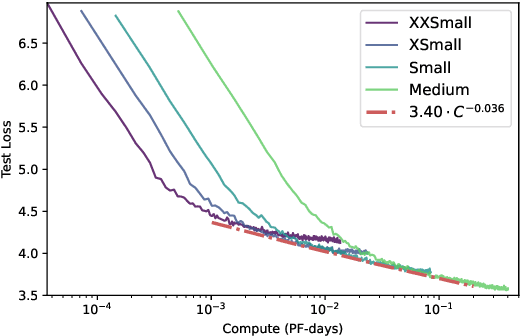
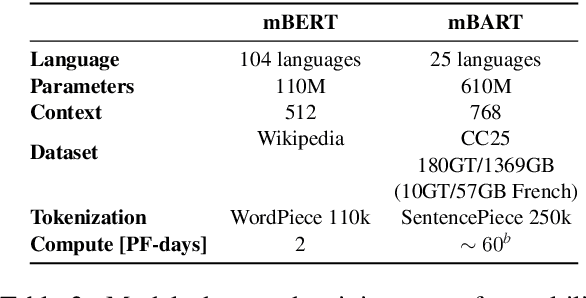

Abstract:Access to large pre-trained models of varied architectures, in many different languages, is central to the democratization of NLP. We introduce PAGnol, a collection of French GPT models. Using scaling laws, we efficiently train PAGnol-XL (1.5B parameters) with the same computational budget as CamemBERT, a model 13 times smaller. PAGnol-XL is the largest model trained to date for the French language. We plan to train increasingly large and performing versions of PAGnol, exploring the capabilities of French extreme-scale models. For this first release, we focus on the pre-training and scaling calculations underlining PAGnol. We fit a scaling law for compute for the French language, and compare it with its English counterpart. We find the pre-training dataset significantly conditions the quality of the outputs, with common datasets such as OSCAR leading to low-quality offensive text. We evaluate our models on discriminative and generative tasks in French, comparing to other state-of-the-art French and multilingual models, and reaching the state of the art in the abstract summarization task. Our research was conducted on the public GENCI Jean Zay supercomputer, and our models up to the Large are made publicly available.
Photonic Differential Privacy with Direct Feedback Alignment
Jun 07, 2021

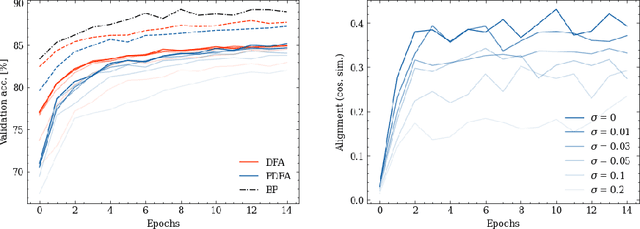
Abstract:Optical Processing Units (OPUs) -- low-power photonic chips dedicated to large scale random projections -- have been used in previous work to train deep neural networks using Direct Feedback Alignment (DFA), an effective alternative to backpropagation. Here, we demonstrate how to leverage the intrinsic noise of optical random projections to build a differentially private DFA mechanism, making OPUs a solution of choice to provide a private-by-design training. We provide a theoretical analysis of our adaptive privacy mechanism, carefully measuring how the noise of optical random projections propagates in the process and gives rise to provable Differential Privacy. Finally, we conduct experiments demonstrating the ability of our learning procedure to achieve solid end-task performance.
Photonic co-processors in HPC: using LightOn OPUs for Randomized Numerical Linear Algebra
May 07, 2021
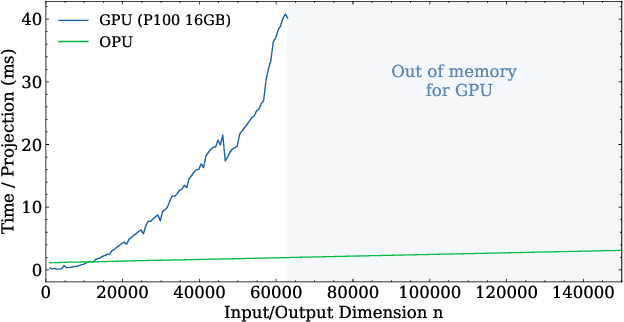
Abstract:Randomized Numerical Linear Algebra (RandNLA) is a powerful class of methods, widely used in High Performance Computing (HPC). RandNLA provides approximate solutions to linear algebra functions applied to large signals, at reduced computational costs. However, the randomization step for dimensionality reduction may itself become the computational bottleneck on traditional hardware. Leveraging near constant-time linear random projections delivered by LightOn Optical Processing Units we show that randomization can be significantly accelerated, at negligible precision loss, in a wide range of important RandNLA algorithms, such as RandSVD or trace estimators.
Adversarial Robustness by Design through Analog Computing and Synthetic Gradients
Jan 06, 2021
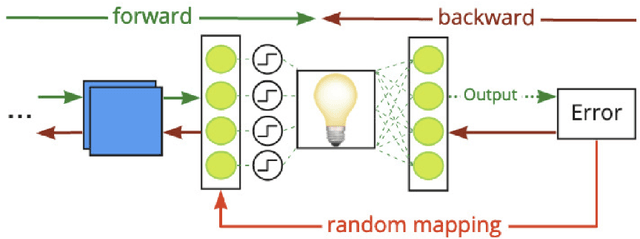


Abstract:We propose a new defense mechanism against adversarial attacks inspired by an optical co-processor, providing robustness without compromising natural accuracy in both white-box and black-box settings. This hardware co-processor performs a nonlinear fixed random transformation, where the parameters are unknown and impossible to retrieve with sufficient precision for large enough dimensions. In the white-box setting, our defense works by obfuscating the parameters of the random projection. Unlike other defenses relying on obfuscated gradients, we find we are unable to build a reliable backward differentiable approximation for obfuscated parameters. Moreover, while our model reaches a good natural accuracy with a hybrid backpropagation - synthetic gradient method, the same approach is suboptimal if employed to generate adversarial examples. We find the combination of a random projection and binarization in the optical system also improves robustness against various types of black-box attacks. Finally, our hybrid training method builds robust features against transfer attacks. We demonstrate our approach on a VGG-like architecture, placing the defense on top of the convolutional features, on CIFAR-10 and CIFAR-100. Code is available at https://github.com/lightonai/adversarial-robustness-by-design.
 Add to Chrome
Add to Chrome Add to Firefox
Add to Firefox Add to Edge
Add to Edge